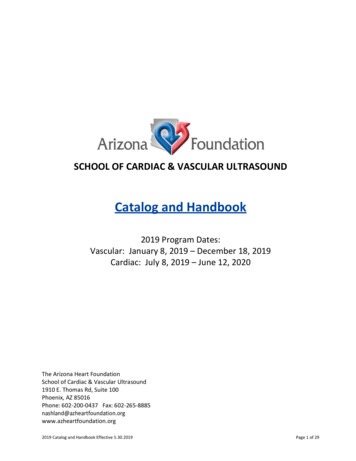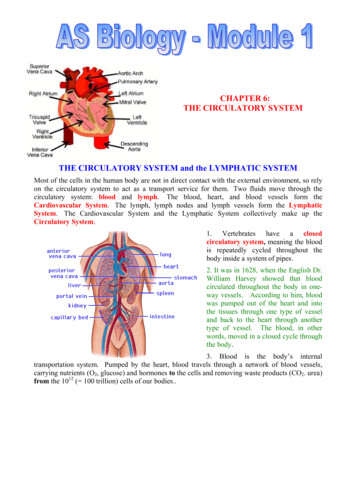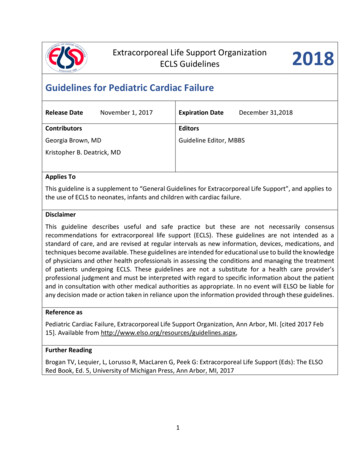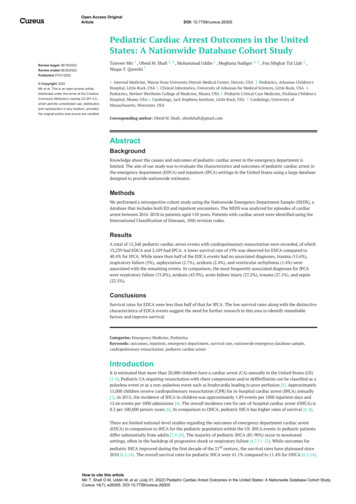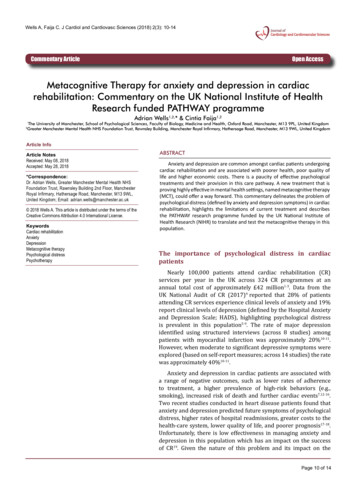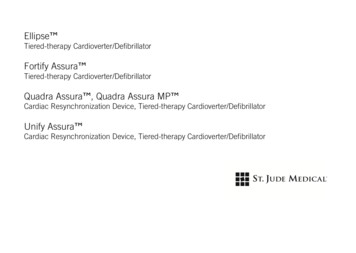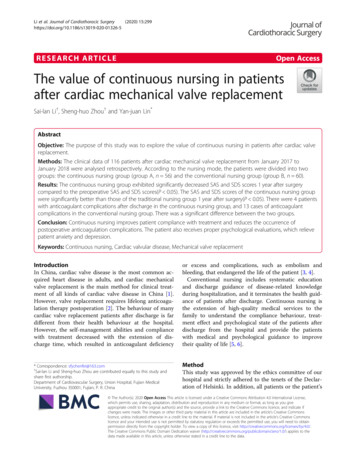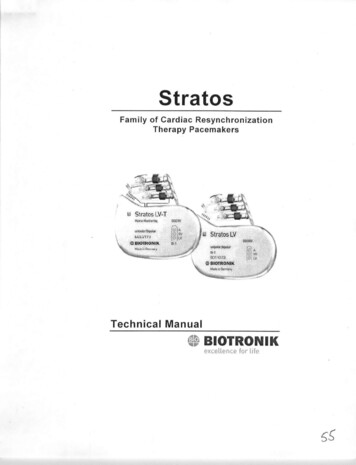
Transcription
StratosFamily of Cardiac ResynchronizationTherapy PacemakersStratosLVaTechnical Manuall BIOTRONIKexcellence for life
Stratos CRT-PsImplantable Cardiac Resynchronization Therapy PacemakersStratosX-Ray identificationRadiopaque IdentificationA radiopaque identification code is visible on standard x-ray, andidentifies the pulse generator:Stratos LV/LV-TOSVCAUTIONLead I CRT-P Compatibility - Because of the numerousavailable 3.2-mm configurations (e.g., the IS-1 and VS-1standards), lead/ CRT-P compatibility should be confirmedwith the CRT-P and/or lead manufacturer prior to theimplantation of the system.IS-1, wherever stated in this manual, refers to the internationalstandard, whereby leads and generators from differentmanufacturers are assured a basic fit. [Reference ISO 58413:1992(E)]. 2008 BIOTRONIK, Inc., all rights reserved.
Stratos LV/LV-T Technical Manual iContents1.1. General .1.1 Device Description . 11.2 In dica tion s . 21.3 Contraindications . 31.4 Note to Physician . 31.5 Warnings and Precautions . 3Interactions with Other Medical Therapy . 41.5.11.5.2 Storage and Sterilization . 61.5.3 Lead Connection and Evaluation . 71.5.4 Programming and Operation . 81.5.5 Home Monitoring . 111.5.6 Electromagnetic Interference (EMI) . 121.5.7 Home and Occupational Environments . 131.5.8 Cellular Phones . 141.5.9 Hospital and Medical Environments . 151.5.10 Device Explant and Disposal . 151.6 Potential Effects of the Device on Health . .16171.7 Clinical Studies .Stratos LV Clinical Study - AVAIL CLS/CRT . 171.7.11.7.2 Stratos LV Clinical Study - OVID study . 381.7.3 AVAIL and OVID Combined PrimaryEndpoint-Complication-free Rate (Safety) . 461.7.4 Tupos LV/ATx Clinical IDE Study OPTION CRT/ATx . 481.7.5 Conclusions Drawn from Studies . 6062.2. Programmable Parameters .622.1 Pacing Modes .2.1.1 Rate-adaptive Modes . 62622.1.2 DDD .2.1.3 DDI . 662.1.4 DVI . 662.1.5 VDD . 662.1.6 AAI and VVI . 672.1.7 AAI, VVI . 672.1.8 AOO, VOO . 672 .1.9 DO O . 6 7.1.10VDI . 6722.1.11 OFF (ODO) . 68s71
ii Stratos LV/LV-T Technical Manual2.2 Biventricular Synchronization of the Stratos CRT-Ps. 68.69.2.3 Timing Functions.69Basic Rate .2.3.1702.3.2 Rate Hysteresis .2.3.3 Scan Hysteresis.712.3.4 Repetitive Hysteresis.732.3.5 Night Mode.742.3.6 Refractory Periods.742.3.7 Atria] PMT Protection.762.3.8 Ventricular Refractory Period.762.3.9 AV Delay.772.3.10 VES Discrimination after Atrial Sensed Events. 792.3.11 Sense Compensation.79792.3.12 Ventricular Blanking Period .80.2.3.13 Safety AV Delay .812.4 Pacing and Sensing Functions .812.4.1Pulse Amplitude and Pulse Width .812.4.2 Sensitivity .822.4.3 Lead Polarity .822.5 Automatic Lead Check .842.6 Antitachycardia Functions: .Upper Rate and UTR Response. 842.6.1.84.2.7 Wenckebach 2:1 .86.2.8 Mode Switching.87.2.9 PMT Management .87.Protection.2.9.188.2.9.2 PMT Detection.2.1 0 Adjustment of the PMT Protection Window . 89892.11 Atria] Upper Rate .2.12 Preventive Overdrive Pacing (Overdrive Mode).902.13 AES Detection and Pacing.912.13.1 AES Detection.9292.2.13.2 Post AES Stimulation932.14 Parameters for Rate-Adaptive Pacing .932.14.1 Rate-Adaptation .2.14.2 Sensor Gain. 93942.14.3 Automatic Sensor Gain .2.14.4 Sensor Threshold.942.14.5 Rate Increase.952.14.6 Maximum Activity Rate.95
Stratos LV/LV-T Technical Manual iii2.14.7 Rate Decay . 9596.2.15 Sensor Stimulation .97.2.16 Rate Fading .982.17 Home Monitoring (Stratos LV-T) . .2.17.1 Transmission of Information . 1002.17.2 Patient Device . 1012.17.3 Transmitting Data . 1012.17.4 Types of Report Transmissions . 1032.17.5 Description of Transmitted Data . 1052 .18 S ta tistics . 10 72.18.1 Timing . 1072.18.2 Arrhythmia . 1072.18.3 Sensor . 1072.18.4 Sensing . 1072.18.5 Pacing . 1072.18.6 General Statistical Information . 1082.19 Interrogating and/or Starting Statistics . . .108109.2.20 Timing Statistics .2.20.1 Event Counter . 1092.20.2 Event Episodes . 1092.20.3 R ate Trend . 1102.20.4 Atrial and Ventricular Rate Histogram . 110111.2.21 Arrhythmia Statistics2.21.1 Tachy Episode Trend . 1112.21.2 AF Classification . 1112.21.3 AES Statistics . 1122.21.4 VES Statistics . 113114.2.22 Sensor Statistics .2.22.1 Sensor Rate Histogram . 1142.22.2 Activity Report . 1152.22.3 Sensor Optimization . 115115.2.23 Sensing Statistics .116.2.24 Pacing Statistics .117.3. Follow-up Procedures .117.Considerations3.1 General119.4. Real-Time IEGM .1194.1 IEGM Recordings .121.5. Battery, Pulse and Lead Data .5.1 Threshold Test - Testing the Pacing Function . 121
iv Stratos LV/LV-T Technical Manual5.2 P/R Measurement - Testing the Sensing Function . 122.1235.3 Testing for Retrograde Conduction .5.4 Non-Invasive Programmed Stimulation (NIPS) . 1235.4.1Description . 1235.4.2 Burst Stimulation . 1245.4.3 Programmed Stimulation . 1245.4.4 Back up Pacing . 1245.4.5 NIPS Safety Features . 125.1276. Other Functions/Features6.1 Temporary Programming . 1276.2 Patient Data Memory . 1286.3 Safe Program Settings . 1286.4 Magnet Effect . 1291296.5 Position Indicator .6.6 Pacing When Exposed to Interference . .1307. Product Storage and Handling . .1337.1 Sterilization and Storage . 133.1347.2 Opening the Sterile Container .7.3 Pulse Generator Orientation.1361378. Lead Connection .1378.1 Lead Configuration .8.2 Lead C onnection. .1389. Elective Replacement Indication (ERI) .14310. Explantation .14711. Technical Data .14911.1 Available Pacing Modes.14911.2 Pulse- and Control Parameters .14911.3 Diagnostic Memory Functions . . .154.15411.4 Home Monitoring (Stratos LV-T) .155.11.5 Additional Functions .11.6 Programmers .15611.7 Default Programs .15711.8 Materials in Contact with Human Tissue . .15711.9 Electrical Data/Battery.15711.10 Mechanical Data . 15812. Order Information .159161.Appendix A .
Stratos LV/LV-T Technical Manual 11. General1.1Device DescriptionThe Stratos LV and Stratos LV-T CRT-Ps are rate adaptivepacemakers designed to provide Cardiac ResynchronizationThe Stratos CRT-Ps provide all standardTherapy (CRT).bradycardia pacemaker therapy with the additional capabilities ofBiventricular pacing in thebiventricular pacing for CRT.Stratos CRT-Ps can be programmed to initially pace in either theright or left ventricular chambers with separately programmableoutputs for both left and right channels. Sensing of cardiacsignals only occurs in the right ventricular chamber.The Stratos CRT-Ps can also provide single and dual chamberpacing in a variety of rate-adaptive and non-rate adaptive pacingPacing capability is supported by an extensivemodes.diagnostic set.For motion-based rate-adaptation, theStratos CRT-Ps are equipped with an internal accelerometer.This sensor produces an electric signal during physical activity ofthe patient. If a rate-adaptive (R) mode is programmed, then theaccelerometer sensor signal controls the stimulation rate.The Stratos LV-T additionally also employs BIOTRONIK's HomeMonitoring TM technology, which is an automatic, wireless, remotemonitoring system for management of patients with implantabledevices. With Home Monitoring, physicians can review dataabout the patient's cardiac status and CRT-P's functionalitybetween regular follow-up visits, allowing the physician tooptimize the therapy process. Stratos CRT-Ps are also designedto collect diagnostic data to aid the physician's assessment of apatient's condition and the performance of the implanted device.The bipolar IS-1 connections are used for pacing and sensing(right atrial and ventricle) and the additional IS-1 connection isused for pacing in the left ventricle in either a bipolar or unipolarconfiguration depending on the left ventricular lead. The pulseamplitude and pulse width of each of the three channels isseparately programmable.
2 Stratos LV/LV-T Technical ManualStratos CRT-Ps are designed to meet all indications for CardiacResynchronization Therapy in CHF patients as well as those forbradycardia therapy as exhibited in a wide variety of patients.The Stratos family is comprised of two CRT-Ps that are designedto handle a multitude of situations.Stratos LVStratos LV-TThroughout thisdescriptions maythose features willto Stratos CRT-Ps1.2Triple chamber, rate-adaptive,unipolar/bipolar pacing CRT-PTriple chamber, rate-adaptive,unipolar/bipolar pacing CRT-P with HomeMonitoringmanual, specific feature and functiononly be applicable to the Stratos LV-T andbe referenced as such. Otherwise, referencerefers to both devices.IndicationsThe Stratos LV and Stratos LV-T Cardiac ResynchronizationTherapy Pacemakers (CRT-Ps) are indicated for patients whohave moderate to severe heart failure (NYHA Class Ill/IV),including left ventricular dysfunction (EF 35%) andQRS 120 ms and remain symptomatic despite stable, optimalheart failure drug therapy.
Stratos LV/LV-T Technical Manual 31.3ContraindicationsUse of Stratos LV and Stratos LV-T CRT-Ps are contraindicatedfor the following patients:**·1.4Unipolar pacing is contraindicated for patients with animplanted cardioverter-defibrillator (ICD) because it maycause unwanted delivery or inhibition of ICD therapy.Single chamber atrial pacing is contraindicated forpatients with impaired AV nodal conduction.Dual chamber and single chamber atrial pacing iscontraindicated for patients with chronic refractory atrialtachyarrhythmias.Note to PhysicianAs with any implantable pulse generator, there are certaininfrequent risks associated with Stratos CRT-Ps. Section 1.6lists the adverse events that have been observed or maypotentially occur with these Cardiac Resynchronization TherapyPacemakers. The warnings and precautions listed in Section 1.5should be taken under serious consideration in order to aid inavoiding device failures and harm to the patient.Regular monitoring of the patient and their implanted deviceshould be conducted to identify performance concerns andensure appropriate therapy is being administered to the patient.Please communicate any performance concerns to BIOTRONIKand to FDA.All explanted devices should be returned to the manufacturer fortesting to help understand device reliability and performance.Refer to Section 10 for recommended procedures for handlingexplanted devices.1.5Warnings and PrecautionsCertain therapeutic and diagnostic procedures may causeundetected damage to a Cardiac Resynchronization TherapyPacemakers, resulting in malfunction or failure at a later time.Please note the following warnings and precautions:1a3
4 Stratos LV/LV-T Technical ManualMagnetic Resonance Imaging (MRI) - Avoid use of magneticresonance imaging as it has been shown to cause movement ofthe CRT-Ps within the subcutaneous pocket and may cause painand injury to the patient and damage to the CRT-P. If theprocedure must be used, constant monitoring is recommended,including monitoring the peripheral pulse.Rate Adaptive Pacing - Use rate adaptive pacing with care inpatients unable to tolerate increased pacing rates.NIPS - Life threatening ventricular arrhythmias can be inducedby stimulation in the ventricle. Ensure that an external cardiacdefibrillator is accessible during tachycardia testing.Onlyphysicians trained and experienced in tachycardia induction andreversion protocols should use non-invasive programmedstimulation (NIPS).High Output Settings - High output settings combined withextremely low lead impedance may reduce the life expectancy ofthe Stratos CRT-Ps. Programming of pulse amplitudes, higherthan 4.8 V, in combination with long pulse widths and/or highpacing rates may lead to premature activation of the replacementindicator.1.5.1 Interactions with Other Medical TherapyBefore applying one of the following procedures, a detailedanalysis of the advantages and risks should be made. Cardiacactivity during one of these procedures should be confirmed bycontinuous monitoring of peripheral pulse or blood pressure.Following the procedures, CRT-P function and stimulationthreshold must be checked.Therapeutic Diathermy Equipment - Use of therapeuticdiathermy equipment is to be avoided for pacemaker patientsdue to possible heating effects of the CRT-P and at the implantsite. If diathermy therapy must be used, it should not be appliedin the immediate vicinity of the CRT-P or leads. The patient'speripheral pulse should be monitored continuously during thetreatment.
Stratos LV/LV-T Technical Manual 5Transcutaneous Electrical Nerve Stimulation (TENS) Transcutaneous electrical nerve stimulation may interfere withCRT-P function. If necessary, the following measures mayreduce the possibility of interference:···Place the TENS electrodes as close to each other aspossible.Place the TENS electrodes as far from the CRT-P/leadsystem as possible.Monitor cardiac activity during TENS use.Defibrillation - The following precautions are recommended tominimize the inherent risk of CRT-P operation being adverselyaffected by defibrillation:*·*The paddles should be placed anterior-posterior or alonga line perpendicular to the axis formed by the CRT-P andthe implanted lead.The energy setting should not be higher than required toachieve defibrillation.The distance between the paddles and the CRT-P/leadsshould not be less than 10 cm (4 inches).Radiation - The CRT-P's internal electronics may be damagedby exposure to radiation during radiotherapy. To minimize thisrisk when using such therapy, the CRT-P should be protectedwith local radiation shielding.Lithotripsy - Lithotripsy treatment should be avoided for CRT-Ppatients since electrical and/or mechanical interference with theCRT-P is possible. If this procedure must be used, the greatestpossible distance from the point of electrical and mechanicalstrain should be chosen in order to minimize a potentialinterference with the CRT-P.Electrocautery - Electrocautery should never be performedwithin 15 cm (6 inches) of an implanted CRT-P or leads becauseof the danger of introducing fibrillatory currents into the heartand/or damaging the CRT-P. Pacing should be asynchronousand above the patient's intrinsic rate to prevent inhibition byinterference signals generated by the cautery. When possible, abipolar electrocautery system should be used.
6 Stratos LV/LV-T Technical ManualFor transurethral resection of the prostate, it is recommendedthat the cautery ground plate be placed under the buttocks oraround the thigh, but not in the thoracic area where the currentpathway could pass through or near the CRT-P system.1.5.2 Storage and SterilizationStorage (temperature) - Recommended storage temperaturerange is 50 to 550C (41 -131 F).Exposure to temperaturesoutside this range may result in CRT-P malfunction (seeSection 7.1).Low Temperatures - Exposure to low temperatures (belowO0C) may cause a false elective replacement indication to bepresent. If this occurs, warm the device to room temperatureand reset the ERI with magnet application (see Section 7.1).Handling - Do not drop. If an unpackaged CRT-P is droppedonto a hard surface, return it to BIOTRONIK (see Section 7.1).FOR SINGLE USE ONLY - Do not re-sterilize the CRT-P oraccessories packaged with the CRT-P, they are intended forone-time use.Device Packaging - Do not use the device if the packaging iswet, punctured, opened or damaged because the integrity of thesterile packaging may be compromised. Return the device toBIOTRONIK.Storage (magnets) - Store the device in a clean area, awayfrom magnets, kits containing magnets, and sources ofelectromagnetic interference (EMI) to avoid damage to thedevice.Temperature Stabilization - Allow the device to reach roomtemperature before programming or implanting the device.Temperature extremes may affect the initial device function.Use Before Date - Do not implant the device after the USEBEFORE DATE because the device may have reduced longevity.
Stratos LV/LV-T Technical Manual 71.5.3Lead Connection and EvaluationLead Check-Feature Description: Lead Check is a feature that, whenactivated, automatically measures the lead impedance with everypace. Based on these measurements, the lead configuration willbe set to either unipolar or bipolar. Refer to Section 2.5 for moredetails regarding this feature.Caution: Lead check will not lead to disabling of cardiacresynchronization therapy.It limits the use of theresynchronization features.1. Lead check is possible only when the right ventricle ispaced first.2. Lead check works only when the pacing voltages areprogrammed between 2.4 and 4.8 V. The lead checkfeature can be programmed OFF in patients that requirecardiac resynchronization therapy.Care should be taken when programming Stratos CRT-Ps withLead Check ON as the device may switch from bipolar tounipolar pacing and sensing without warning. This situation maybe inappropriate when using a Stratos CRT-P for patients with anImplantable Cardioverter Defibrillator (ICD). The followingassociated message appears when programming this feature:"Lead check may result in a switch to unipolar pacing andsensing, which may be inappropriate for patients with anICD."Additionally, Lead Check should be programmed OFF beforelead connection as the feature will automatically reprogram thedevice to unipolar in the absence of a lead.Lead / CRT-P Compatibility - Because of the numerousavailable 3.2-mm configurations (e.g., the IS-1 and VS-1standards), lead/ CRT-P compatibility should be confirmed withthe CRT-P and/or lead manufacturer prior to the implantation ofthe system.IS-1, wherever stated in this manual, refers to the internationalstandard, whereby leads and generators from differentmanufacturers are assured a basic fit. [Reference ISO 58413:1992(E)].
8 Stratos LV/LV-T Technical ManualLead Configuration - The polarity of the implanted lead dictateswhat lead configuration can be programmed for the CRT-P.Pacing will not occur with a unipolar lead if the lead configurationof the respective channel is programmed to bipolar (seeSection 8).Setscrew Adjustment - Back-off the setscrew(s) prior toinsertion of lead connector(s) as failure to do so may result indamage to the lead(s), and/or difficulty connecting lead(s).Cross Threading Setscrew(s) - To prevent cross threadingthe setscrew(s), do not back the setscrew(s) completely out ofthe threaded hole. Leave the torque wrench in the slot of thesetscrew(s) while the lead is inserted.Tightening Setscrew(s) - Do not overtighten the setscrew(s).Use only the BIOTRONIK supplied torque wrench.Sealing System - Be sure to properly insert the torquewrench into the perforation at an angle perpendicular to theconnector receptacle. Failure to do so may result in damage tothe plug and its self-sealing properties.1.5.4 Programming and OperationIEGM - Due to the compression processes that the signalsundergo, the IEGM recordings are not suitable for making somespecific cardiac diagnoses, such as ischemia; although, thesetracings may be useful in diagnosing arrhythmias, devicebehavior or programming issues.Post AES - Before activating post-AES, check whether theselected program can cause Pacemaker Mediated Tachycardia(PMT) and whether post-AES pacing results.Overdrive Pacing Mode - When programming the overdrivepacing mode, check whether the selected program can causePMT, and whether atrial over drive pacing would result.Corresponding to the measured retrograde conduction time, thePMT protection interval must be programmed to a correct value.AV Hysteresis - If the AV hysteresis is enabled along with thealgorithm for recognizing and terminating PMTs (PMTmanagement), the AV delay for recognizing and terminating aPMT has a higher priority than the AV hysteresis.
Stratos LV/LV-T Technical Manual 9Sensing - The Stratos CRT-Ps do not sense in the left ventricle.AV Conduction - In patients with intact AV conduction, theintrinsic atrial tachycardia is conducted to the ventricle 1:1. Withthe resynchronization mode activated, spontaneous rate of theright ventricle mode is synchronized for a rate up to 200 ppm inthe left ventricle. For this reason, biventricular pacing modeshould be turned OFF in such cases.Unipolar/Bipolar - If the pacing or sensing function is to beprogrammed to bipolar in the atrial channel, it must be verifiedthat bipolar leads have been implanted in that chamber. If theatrial lead is unipolar, unipolar sensing and pacing functionsmust be programmed in that chamber. Failure to program theappropriate lead configuration could result in patient experiencingentrance and/or exit block.In addition, if the atrial lead polarity setting within the Patient DataMemory has been set to bipolar, the polarity of thecorresponding implanted lead must be confirmed to be bipolar.Safe Program - Activating the "Safe Program" is a way ofquickly programming the device to multiple settings in the eventof an emergency. These settings include unipolar pacing withpacing output OFF in the left ventricular channel. Refer toSection 6.3 for further details.Programmers - Use only BIOTRONIK's ICS 3000 programmerequipped with appropriate software to program Stratos CRT-Ps.Do not use programmers from other manufacturers.Pulse Amplitude - Programming of pulse amplitudes, higherthan 4.8 V, in combination with long pulse widths and/or highpacing rates can lead to premature activation of the replacementindicator. If a pulse amplitude of 7.2 V or higher is programmedand high pacing rates are reached, output amplitudes may differfrom programmed values.Pacing thresholds - When decreasing programmed output(pulse amplitude and/or pulse width), the pacing threshold mustfirst be accurately assessed to provide a 2:1 safety margin.
10 Stratos LV/LV-T Technical ManualEMI - Computerized systems are subject to (ElectromagneticIn the presence of suchInterference (EMI) or "noise".interference, telemetry communication may be interrupted andprevent programming of the Stratos CRT-P.Programming Modifications - Extreme programming changesshould only be made after careful clinical assessment. Clinicaljudgment should be used when programming permanent pacingrates below 40 ppm or above 100 ppm.Short Pacing Intervals - Use of short pacing intervals (highpacing rates) with long atrial and/or ventricular refractory periodsmay result in intermittent asynchronous pacing and, therefore,may be contraindicated in some patients.OFF Mode - The OFF mode can be transmitted as a temporaryprogram only to permit evaluation of the patient's spontaneousrhythm. (see Section 2.1.11)Myopotential Sensing - The filter characteristics ofBIOTRONIK implantable devices have been optimized to senseelectrical potentials generated by cardiac activity and to reducethe possibility of sensing skeletal myopotentials. However, therisk of CRT-P's operation being affected by myopotentials cannotbe eliminated, particularly in unipolar systems. Myopotentialsmay resemble cardiac activity, resulting in inhibition of pacing,triggering and/or emission of asynchronous pacing pulses,depending on the pacing mode and the interference pattern.Certain follow-up procedures, such as monitoring CRT-Pperformance while the patient is doing exercises involving theuse of pectoral muscles, as well as Holter monitoring, have beento check for interference caused byrecommendedIf sensing of myopotentials is encountered,myopotentials.corrective actions may include selection of a different pacingmode or sensitivity setting.Muscle or Nerve Stimulation - Inappropriate muscle or nervestimulation may occur with unipolar pacing when using a noncoated Stratos CRT-P.Atrial Sensitivity - In dual chamber systems, the atrialsensitivity of 0.1 mV should only be programmed in conjunctionwith a bipolar lead configuration.-i/0
Stratos LV/LV-T Technical Manual 11Programmed to Triggered Modes - When programmed totriggered modes, pacing rates up to the programmed upper limitmay occur in the presence of either muscle or externalinterference.Triggered Modes - While the triggered modes (DDT, DVT,DDTR/A, DDTRN, DDIIT, VDT, WVT, and AAT) can beprogrammed permanently, these modes are intended for use astemporary programming for diagnostic purposes. In triggeredpacing modes, pacing pulses are emitted in response to sensedsignals, and therefore the pacing pulse can be used as anindicator, or marker of sensed events for evaluating the sensingfunction of the pulse generator using surface ECG. However,real-time telemetry of marker channels and/or intracardiacelectrogram via the programmer and pr
The Stratos LV-T additionally also employs BIOTRONIK's Home Monitoring TM technology, which is an automatic, wireless, remote monitoring system for management of patients with implantable devices. With Home Monitoring, physicians can review data about the patient's cardiac status and CRT-P's functionality


